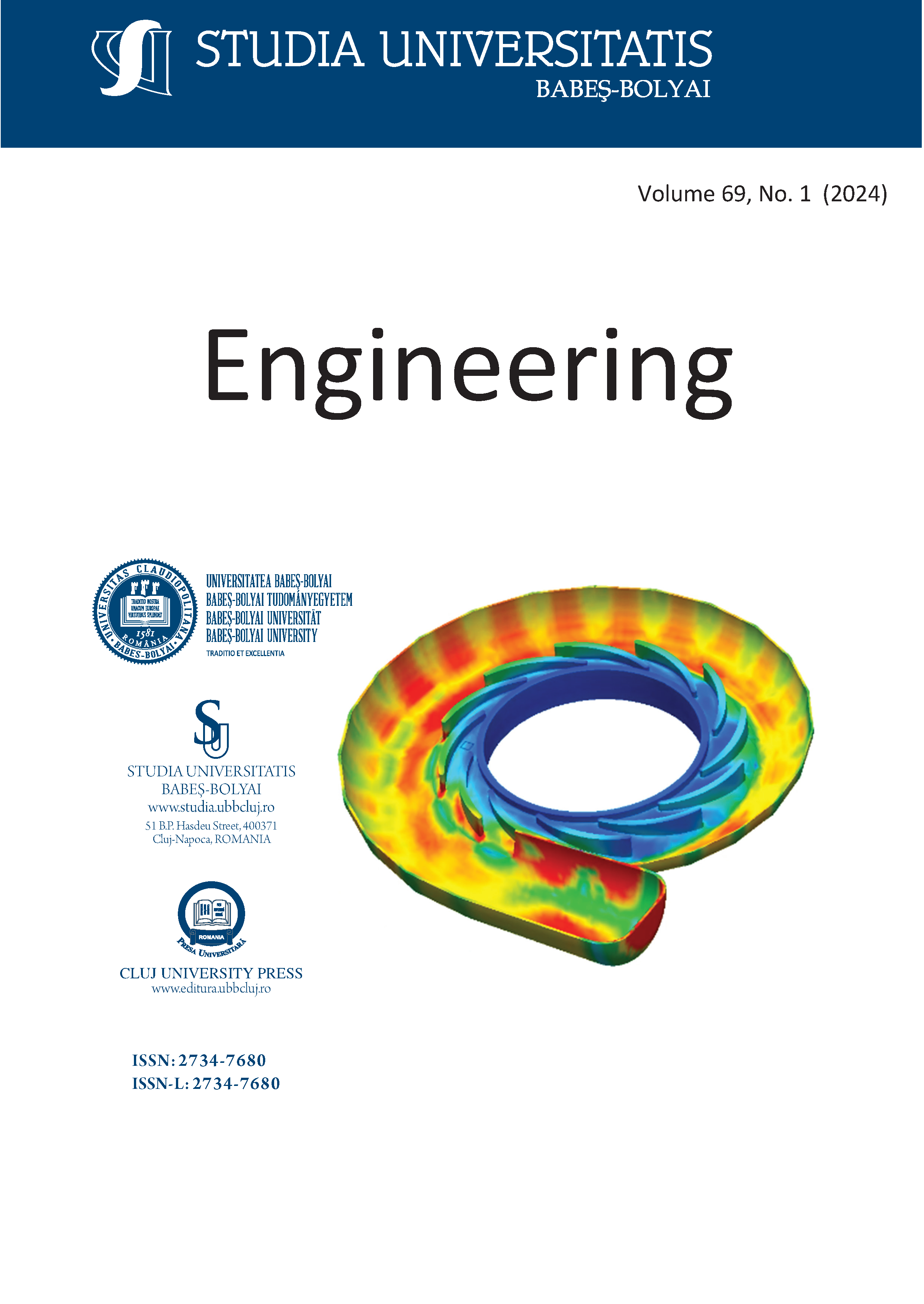Development and evaluation of a COOI24m pelletizer
DOI:
https://doi.org/10.24193/subbeng.2024.1.18Keywords:
Machine, pellets, pelletizing, moisture content, compositions, pellet-mash, local, farmersAbstract
It is essential to formulate appropriate feeding pellets with the required nutrient compositions for poultry animals to meet the growing demand for protein through the provision of eggs and meat. Forming the required feed concentrates into pellet-mash requires a pelletizing machine, which is, in most cases, very expensive for the local farmers due to the high foreign exchange rate. Based on this, the study focuses on the development of a simple and affordable pelletizing machine from locally sourced materials. The machine consists of a frame, hopper, die roller, pelletizer, and internal combustion (5.5 hp), and it was run at 950, 600, and 450 revolutions per minute. The formation and discharge of pellets from the machine increased with the pelletizing efficiency (Pe) of 70.3% to 84.6% at a moisture content (MC) of 15.8% to 27.1%, and the Pe decreased at a moisture content above 29.0%. Also, the drying temperature (DT) has a significant effect on the pellet moisture content (MC) and bulk density at P > 0.05. The effects of weather conditions on pellets produced using the COOI24m pelletizer were assessed in this study. The analysis showed that changes in weather conditions had an insignificant effect on the quality and properties of the pellets. The machine is highly recommended for use by small-scale livestock farmers for the local production of pellet-mash of different compositions because of its affordability, ease of use, and high working efficiency.
References
F. Vanschoubroeck, L. Coucke, R. Spaendonck, The quantitative effect of pelleting feed on the performance of piglets and fattening pigs. Nutr. Abstr. Rev. 41, 2021, pp.1-9.
W.G. Pond, J.G. Maner, Swine Production and Nutrition Animal Science, Textbook series AVI Publ.Co., Inc., Westport, Connecticut, USA. 2014, 646pp.
C. Calet, The relative value of pellets versus mash and grain in poultry nutrition, World. Poult. 21: 2005, pp.23–52.
A.F.B. Van der Poel, M.W.A. Verstegen, S. Tamminga, Chemical, physical and nutritional effects of feed processing technology, 16”‘ Western nutrition conference, Sept. 13-14, 2015, Saskatoon, Saskatchewan, Canada. pp. 266.
J. S. Tumuluru, Effect of process variables on the density and durability of the pellets made from high moisture corn stover, Biosystems Engineering, 119, 2014, pp.44 – 57.
H.B. Pfost, Testing the durability of pelleted feed, Feedstuffs. World. Poult. 21, 2013, pp. 66 –68.
J.T. Pope, Non-conditioning factors affecting enzyme thermostability during feed processing [PhD dissertation]. Raleigh (NC): North Carolina State University, Department of Poultry Science, 2019.
C.N. Truelock, Influence of exogenous enzymes and pelleting on feed manufacturing and broiler performance, [PhD dissertation]. Manhattan (KS): Kansas State University, Department of Grain Science, 2020.
L.E. Heffner, H.B. Pfost, Gelatinisation during pelleting, Feedstuffs, 2013. pp. 45:32.
H.S. Bayley, J.D Summers, S.J. Slinger, The effect of steam pelleting feed ingredients on chick performance: Effect on phosphorous availability, metabolizable energy value and carcass composition, Poult. Sci., 47, 2018, pp. 1140–1148.
D.E. Maier, J. Gardecki, Evaluation of pellet conditioning: Understanding steam, Feed Manage., 2013, 44:15.
E.R. Skoch, K.C. Behnke, C.W. Deyoe, .F. Binder, The effect of steam conditioning rate on the pelleting process, Anim. Feed Sci. Technol. 6, 2018, pp. 83-90.
M. Thomas, A.F.V. van der Poel, Fundamental factors in feed manufacturing: Towards a unifying conditioning/pelleting framework. Anim. Feed Sci. Technol., 268, 2020, pp.1-8.
C.R. Stark, Feed Processing to Improve Poultry Performance, Arkansas Nutrition Conference, Rogers, AR, 2012.
L. Reimer, Conditioning. Northern Crops Institute, Feed Mill Management and Feed Manufacturing Technology Short Course. California Pellet Mill Co., 2022 Pg. 7.
E.R. Skoch, K.C. Behnke, C.W. Deyoe, S.F. Binder, The effect of steam conditioning rate on the pelleting process, Anim. Feed Sci. Technol., 6, 2018, pp. 83-90.
A.T. Ishola, A.R. Busari, O.S. Aboyeji, Effects of Operating Parameters on the Performance of a Mixer cum Pelletizer for Livestock Feeds, Journal of Research Information in Civil Engineering, 18 (2), 2021, pp. 4116-4132.
D. Ziggers, Die determines pellet production. Feed Technol., 7. 2013, pp. 17-19.
A.A. Balami, D. Adgidzi, A. Mua’zu. Development and Testing of an Animal Feed Mixing Machine, International Journal of Basic and Applied Science, 1(3), 2013, pp. 491-503.
N.N. Collins, O.A. Olasunkanmi, Development of a Dual-Mode Laboratory-Sized Pelletizing Machine, Leonardo Journal of Sciences, 13: 2008, pp. 22 - 29.
Downloads
Published
How to Cite
Issue
Section
License
Copyright (c) 2024 Studia Universitatis Babeș-Bolyai Engineering

This work is licensed under a Creative Commons Attribution-NonCommercial-NoDerivatives 4.0 International License.





 © Studia Universitatis Babeş-Bolyai Engineering. Published by Babeș-Bolyai University.
© Studia Universitatis Babeş-Bolyai Engineering. Published by Babeș-Bolyai University.